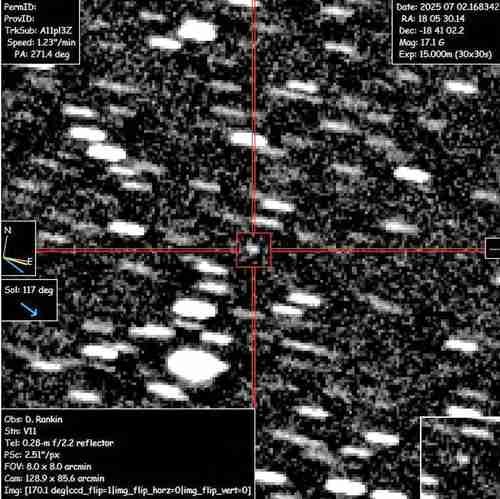Amateur astronomers and civilians collaborate in the discovery of an exploding star.

Amateur astronomers and civilians collaborate in the discovery of an exploding star.
It devours
a stellar companion from which it steals matter, causing an explosion of light and brightness.
▲ In the image, the exploding star named GOTO0650, which represents the first major discovery of the Kilonova Seekers citizen astronomy project. Photo Europa Press
Europa Press
La Jornada Newspaper, Friday, July 4, 2025, p. 6
Madrid. Astronomers from the University of Warwick have collaborated with citizen scientists to discover a new, extremely bright, exploding star that is devouring a stellar companion.
The newly observed binary system features a cataclysmic variable star, designated GOTO0650, in a rarely seen late stage of its evolution. This was also the first major discovery by the Kilonova Seekers citizen astronomy project.
Previously described as a spot-the-difference
astronomy game, Kilonova Seekers invites the public to compare the most recent images of a section of the night sky with an image of the same section taken on previous nights. Their goal: to detect new stars or significant changes in light intensity that might indicate something extraordinary has happened in space.
The brightness in the night sky increased 2,500 times
The exploding star was spotted when its brightness in the night sky increased 2,500 times compared to when that spot in the sky was photographed a few days earlier. The rapid response and hard work of the public allowed the object to be studied and classified in the early stages of its evolution, identifying it as a cataclysmic variable star.
Dr. Tom Killestein, Co-Director of Kilonova Seekers and a Warwick Prize Fellow from the University of Warwick’s Astronomy and Astrophysics Group, said in a statement: “Kilonova Seekers offers a unique opportunity for the public to participate in real-time astrophysics. Remarkably, public volunteers identified this star as an object of interest within three and a half hours of the GOTO image being taken; this discovery might have gone unnoticed among many other objects without their efforts
.”
Cataclysmic variable stars sporadically increase their brightness by large amounts before returning to normal levels. They are compact binary star systems, composed of a white dwarf that steals matter from its companion donor star. Periodically, the donor star's material reaches a critical density and temperature within the gas disk surrounding the white dwarf, causing an explosion and bright flashes of light.
The rapid public response enabled the team to obtain an exceptionally comprehensive data set on the star, including spectroscopy, X-ray, and ultraviolet measurements, complemented by extremely high-quality observations made by amateur astronomers. These observations suggest that this is a period bounce, the final state of a cataclysmic variable star, and a difficult object to find, even in the era of wide-field imaging surveys.
NASA discovers the third known interstellar object to pass through the Solar System

▲ The image shows interstellar object A11pI3Z, located in the constellation of Sagittarius. It is estimated to be 20 kilometers in diameter and is the third ever detected. Photo AFP / David Rankin, Saguaro Observatory
AP and Europa Press
La Jornada Newspaper, Friday, July 4, 2025, p. 6
Florida. NASA's Asteroid Terrestrial-impact Last Alert System (ATLAS) has discovered the third known interstellar object to pass through the Solar System.
Initially named A11pl3Z and originating in the constellation of Sagittarius, it is estimated to be about 20 kilometers in diameter, much larger than Oumuamua and Borisov, the two known interstellar objects.
Being monitored by telescopes around the world, according to ESA, this object is currently approximately 670 million kilometers from the Sun and is hurtling toward our inner system. It is moving at nearly 68 kilometers per second and will pass close to Mars and the Sun later this year.
The International Astronomical Union's Minor Planet Center has already classified the object as a comet, with the designation 3I/ATLAS, and it could contain clues to another star system.
Pascal Lee, a planetary scientist at the SETI Institute, commented on his X account that it is already in Jupiter's orbit. Its closest approach to the Sun is expected on October 29, and its closest approach to Earth will be on October 30 at 1.35 astronomical units, so there is no risk of impact.
3I/ATLAS should remain visible to ground-based telescopes until September, after which it will pass too close to the Sun to be observed. It is expected to reappear on the far side of the Sun in early December, allowing for further observations, according to NASA.
Its light curve has not yet been published, so there is no information yet on its shape or rotation.
Astrophysicist Josep Trigo-Rodríguez of the Institute of Space Sciences near Barcelona, Spain, believes it is an interstellar object based on its strange trajectory and extreme speed as it passes through the solar system. He estimates its size to be approximately 40 kilometers (25 miles) in diameter.
The first confirmed interstellar visitor was in 2017. Nicknamed Oumuamua , which means explorer in Hawaiian, after the observatory in Hawaii that discovered it. Initially classified as an asteroid, the elongated Oumuamua has since shown signs of being a comet.
The second object to deviate from another star system toward ours is 21/Borisov, discovered in 2019.
jornada





